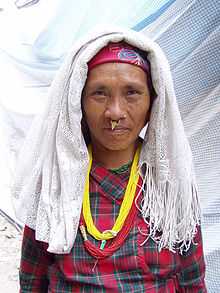Women in Nepal
 Woman in Nepal, 2007 | |
| Gender Inequality Index[1] | |
|---|---|
| Value | 0.485 (2012) |
| Rank | 102nd out of 148 |
| Maternal mortality (per 100,000) | 170 (2010) |
| Women in parliament | 33.2% (2012) |
| Females over 25 with secondary education | 17.9% (2010) |
| Women in labour force | 80.4% (2011) |
| Global Gender Gap Index[2] | |
| Value | 0.6053 (2013) |
| Rank | 121st out of 136 |
| Women in society |
|---|
 |
|
|
|
Popular culture |
|
As of the early 1990s, women in Nepal were generally subordinate to men in virtually every aspect of life. Nepal was a rigidly patriarchal society.
Women's relative status, however, varied from one ethnic group to another. The status of women in Tibeto-Nepalese communities generally, was relatively better than that of Pahari and Newari women. Women from the low caste groups also enjoyed relatively more autonomy and freedom than Pahari and Newari women.
The senior female member played a commanding role within the family by controlling resources, making crucial planting and harvesting decisions, and determining the expenses and budget allocations. Yet women's lives remained centered on their traditional roles —taking care of most household chores, fetching water and animal fodder, and doing farm work. Their standing in society was mostly contingent on their husbands' and parents' social and economic positions. They had limited access to markets, productive services, education, health care, and local government. Malnutrition and poverty hit women hardest. Female children usually were given less food than male children, especially when the family experienced food shortages. Women usually worked harder and longer than men. By contrast, women from high-class families had maids to take care of most household chores and other menial work and thus worked far less than men or women in lower socioeconomic groups.
The economic contribution of women was substantial, but largely unnoticed because their traditional role was taken for granted. When employed, their wages normally were 25 percent less than those paid to men. In most rural areas, their employment outside the household generally was limited to planting, weeding, and harvesting. In urban areas, they were employed in domestic and traditional jobs, as well as in the government sector, mostly in low-level positions.
One tangible measure of women's status was their educational attainment. Although the constitution offers women equal educational opportunities, many social, economic, and cultural factors contributed to lower enrollment and higher dropout rates for girls. Illiteracy imposed the greatest hindrance to enhancing equal opportunity and status for women. They were caught in a vicious circle imposed by the patriarchical society. Their lower status hindered their education, and the lack of education, in turn, constricted their status and position. Although the female literacy rate has improved noticeably over the years, the level in the early 1990s fell far short of the male level.
The level of educational attainment among female children of wealthy and educated families was much higher than that among female children of poor families. This class disparity in educational attainment was also true for boys. In Nepal, as in many societies, education was heavily class-biased.
In the early 1990s, a direct correlation existed between the level of education and status. Educated women had access to relatively high-status positions in the government and private service sectors, and they had a much higher status than uneducated women. This general rule was more applicable at the societal level than at the household level. Within the family, an educated woman did not necessarily hold a higher status than her uneducated counterpart. Also within the family, a woman's status, especially a daughter-in-law's status, was more closely tied to her husband's authority and to her parental family's wealth and status than anything else.
References
- ↑ "Human Development Report". United Nations Development Programme. 2013. p. 156.
- ↑ "The Global Gender Gap Report 2013". World Economic Forum. pp. 12–13.
![]() This article incorporates public domain material from websites or documents of the Library of Congress Country Studies. (Data as of 1991.)
This article incorporates public domain material from websites or documents of the Library of Congress Country Studies. (Data as of 1991.)
External links
| Wikimedia Commons has media related to Women of Nepal. |
| ||||||||||||||||||||||||||||||||||||||||||||||||||||||||||||
